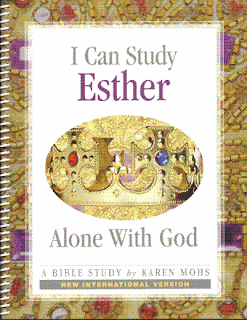In September, I was given a copy of Green 'n' Stuff's bible study "I Can Study Esther Alone with God" in exchange for my review. While most people are familiar with this company because of their super popular Greek program, "Hey Andrew, Teach me Some Greek!", the bible studies are part of their product line, and are worth consideration.
Over the course of the last school year, my daughter (9) has worked through this bible study. While she is the kind of student who prefers to complete assignments, units, chapters, and courses as quickly as she can (her attitude is always, "Why do one lesson when I have time to finish ten!?"), I encouraged her to follow the schedule for this bible study, since the Word of God is best digested in small bites rather than in huge meals. She complied, and read a couple of verses of the Book of Esther every day, along with answering the provided questions. Weekly memory verses are also provided. The study lasts for 13 weeks with very short lessons daily Monday-Saturday. An example day's lesson looks like this:
The most interesting part of this bible study, certainly from my perspective, are the questions and answers that are included along with each lesson. For example, in week two, there is a reference in Esther to the Jews still being in Persia. Karen Mohs, the author of the study, clarifies this in a sidebar, indicating that only about 50,000 Jews had returned to the homeland at this time. I have a minor in Theology, but I have never studied the Book of Esther, and I learned much from this study. My daughter has a huge advantage over me at this point, as she now has a wonderful comprehension and recall of this piece of the Old Testament.
I should mention that I am a Roman Catholic, and while this study is quite obviously written by Protestants, I wouldn't limit its usage to Protestants at all. I found nothing in this study that counters Catholic teaching, and the fact is that there just aren't as many Catholic bible study products out there. If you want to introduce your children in-depth to the Book of Esther, I would wholeheartedly recommend this product. Because it is based primarily on simply a reading and recall of Scripture, rather than on promoting or educating about a particular denomination of Christianity, it is ideally suited to anyone who has a desire for her child independently to complete a bible study.
"I Can Study Esther Alone with God" is available from Greek 'n' Stuff's website, and is priced at a very reasonable $8.95. It is recommended for middle to upper elementary students, and I found this target age to be exactly right. I thoroughly enjoyed watching my daughter progress through this bible study. To see what other Crew members thought, visit the Crew Blog.






















